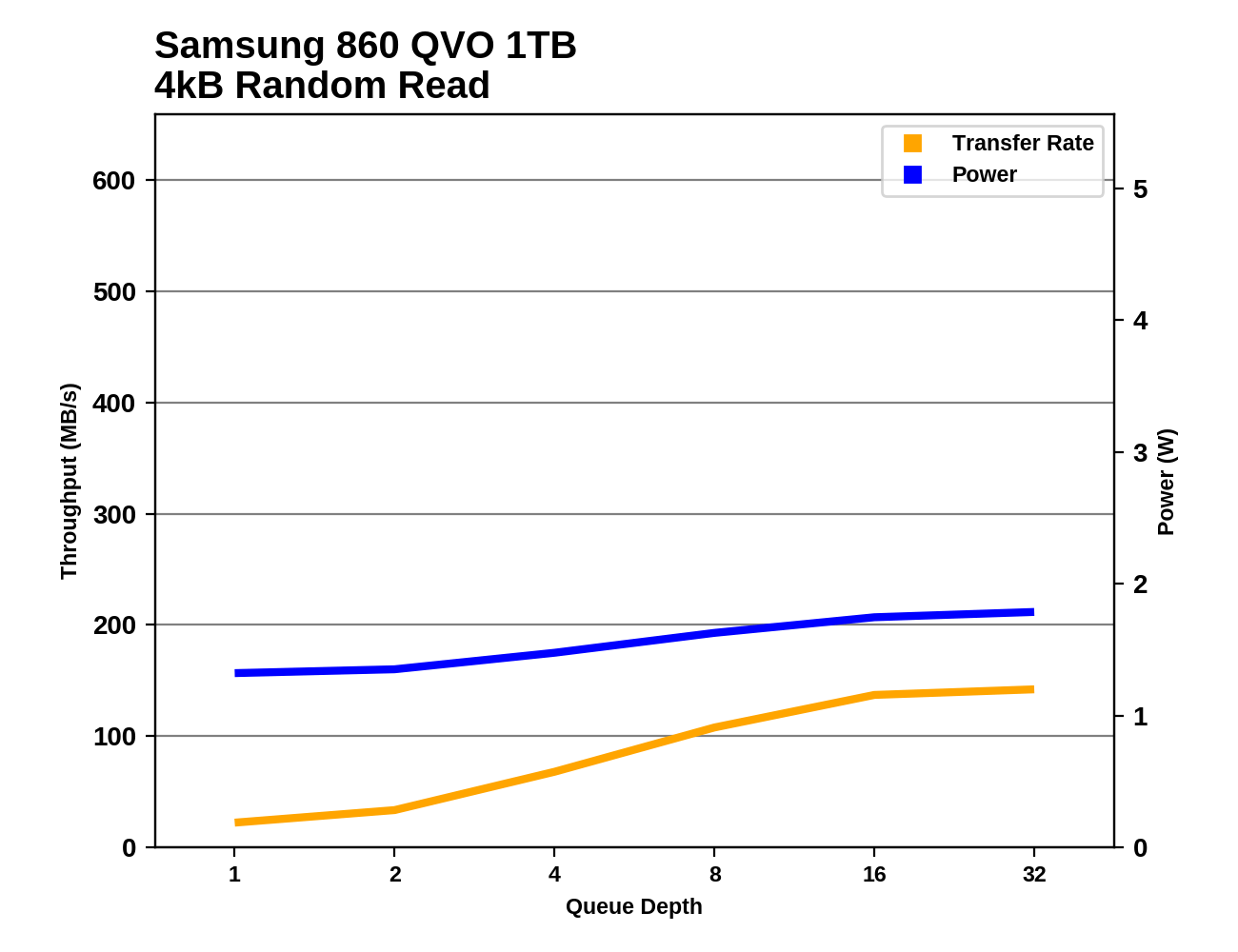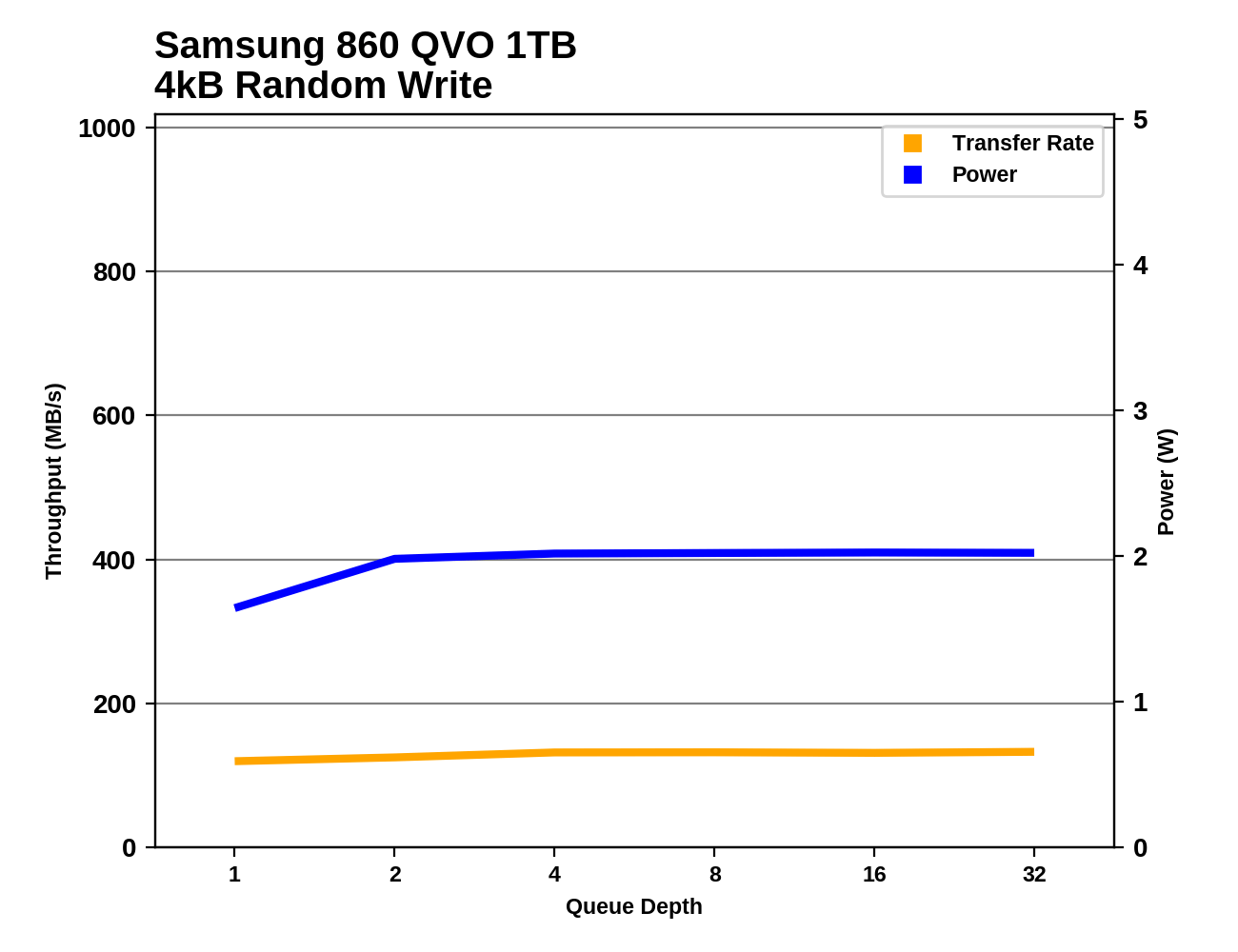The Samsung 860 QVO (1TB, 4TB) SSD Review: First Consumer SATA QLC
by Billy Tallis on November 27, 2018 11:20 AM ESTRandom Read Performance
Our first test of random read performance uses very short bursts of operations issued one at a time with no queuing. The drives are given enough idle time between bursts to yield an overall duty cycle of 20%, so thermal throttling is impossible. Each burst consists of a total of 32MB of 4kB random reads, from a 16GB span of the disk. The total data read is 1GB.

The burst random read performance of the Samsung 860 QVO is clearly lower than the 3D TLC competition, while the Intel/Micron QLC NVMe drives have no trouble competing against the field of mainstream SATA TLC drives. Even in the worst case of the smallest QVO being entirely full, read speeds are still vastly better than a hard drive.
Our sustained random read performance is similar to the random read test from our 2015 test suite: queue depths from 1 to 32 are tested, and the average performance and power efficiency across QD1, QD2 and QD4 are reported as the primary scores. Each queue depth is tested for one minute or 32GB of data transferred, whichever is shorter. After each queue depth is tested, the drive is given up to one minute to cool off so that the higher queue depths are unlikely to be affected by accumulated heat build-up. The individual read operations are again 4kB, and cover a 64GB span of the drive.

On the longer random read test, the Toshiba TR200 DRAMless TLC drive is no longer able to stay ahead of the 860 QVO, and even the Intel/Micron QLC drives fall behind most mainstream SATA drives (especially when full).
 |
|||||||||
| Power Efficiency in MB/s/W | Average Power in W | ||||||||
The power consumption of the 860 QVO during the random read test is only slightly higher than its TLC-based relatives, but that's plenty to push its efficiency scores into last place, given the poor performance.
 |
|||||||||
The queue depth scaling of the 860 QVO during random reads is fairly typical in shape, with improvements starting to taper off after QD16. However, the vertical scale is important: the QVO doesn't ever reach even half the performance of the best TLC-based SATA SSDs.
Looking at the 1TB 860 QVO's random read results compared to all the other SATA drives in the benchmark database, it is clear that the QVO isn't anywhere near the cutting edge for power efficiency or peak performance, but there are worse drives out there.
Random Write Performance
Our test of random write burst performance is structured similarly to the random read burst test, but each burst is only 4MB and the total test length is 128MB. The 4kB random write operations are distributed over a 16GB span of the drive, and the operations are issued one at a time with no queuing.

The SLC cache of the 860 QVO is very effective for the burst random write test, leaving it tied or slightly ahead of the 860 EVO.
As with the sustained random read test, our sustained 4kB random write test runs for up to one minute or 32GB per queue depth, covering a 64GB span of the drive and giving the drive up to 1 minute of idle time between queue depths to allow for write caches to be flushed and for the drive to cool down.

On the longer random write test, the larger SLC cache and greater parallelism of the 4TB 860 QVO helps it keep pace with other top SATA SSDs, but the 1TB QVO has to settle for being slightly faster than the DRAMless TLC drive.
 |
|||||||||
| Power Efficiency in MB/s/W | Average Power in W | ||||||||
The QVO is again a bit more power hungry than most of the TLC drives, which doesn't hurt the 4TB QVO's efficiency score much thanks to its good performance, but the 1TB QVO ends up tied for last place with the full-drive performance from the Intel/Micron QLC drives.
 |
|||||||||
The 1TB 860 QVO shows very little random write performance scaling with increasing queue depth, though power consumption does go up significantly from QD1 to QD2. The 4TB 860 QVO shows a much more typical scaling up to saturation at QD4, with a performance curve that is almost an exact match for the 4TB 860 EVO.
There are some TLC SATA SSDs that draw the same power to deliver half the random write performance of the 1TB 860 QVO, but in the grand scheme of things the 1TB QVO's results on this test are sub-par. The 4TB starts out in the same spot but ends up hitting the SATA performance wall without consuming too much power.












109 Comments
View All Comments
nathanddrews - Tuesday, November 27, 2018 - link
Still leaps and bounds beyond 7200RPM hard drives, but not great either. If we could just get to SATA3 equivalent performance at this price/GB, it would be great. 4TB for that cheap is pretty awesome though, I might grab one if it goes on sale.Makaveli - Tuesday, November 27, 2018 - link
Your review conclusion was much easier on this drive than the Tech Report review.Basically buy a 860Evo this drive is trash is what I get when I read all the reviews on the net today. Only people that don't follow the industry will be suckered into buying these because of that attractive low price.
Like everything in this world you get what you pay for.
Billy Tallis - Tuesday, November 27, 2018 - link
I didn't want to over-emphasize the price issue because I don't think that situation will last very long. Samsung may end up dropping prices before the QVO even hits the shelves, and within a few months I think it will be significantly cheaper than the EVO, which means it should also be cheaper than all the other mainstream TLC drives and the handful of high-capacity DRAMless TLC drives. Once the novelty wears off and the pricing settles down, I fully expect the QVO to end up being a very reasonable entry-level buy.hanselltc - Wednesday, November 28, 2018 - link
It'll not only have to be significantly cheaper than the EVO series -- I think it'll have to compete with HDD arrays.The_Assimilator - Thursday, November 29, 2018 - link
This sort of forward-thinking bigger-picture non-knee-jerk reviewing is why I keep coming back to AnandTech. People can pan this drive and QLC all they want, but Samsung's gonna be laughing all the way to the bank once QLC starts eating HDDs' lunch, and then those same sites that trashed them will be calling them visionary.BTW Billy, please do keep us updated on the 4TB failures you saw - since that capacity is likely going to be the best in terms of cost/GB, a lot of people will be considering 4TB Samsung SSDs, and if there is a controller/firmware/NAND issue lurking it would be great to know about it beforehand.
AbRASiON - Tuesday, November 27, 2018 - link
Hi,I know it's an odd request but I don't follow reviews as much as I used to.
I'd love to see a couple of graphs on this chart, just showing perhaps a very early generation SSD or even a regular high end 7200RPM hard drive.
Scale is all but lost when you don't recognise the disks it's comparing against.
I know the 860/960 Evos are powerful, I can see this disk is much slower, but will it totally destroy a hard drive or Intel G2 160GB classic in all benchmarks? Etc
TekWiz - Tuesday, November 27, 2018 - link
Well sure it will destroy a hard drive! It's slower than the EVO but still is a pretty good SSD. It's aimed at people who want high capacity for as least money as possible. I bet if the list price is $150, it will probably end up costing about $20 less than an equivalent EVO.It's like comparing the PRO to the EVO, it's more expensive but has higher performance. But any of these quality SSD totally beat spinning disks particularly when it's not just sequential reads. In normal use, sequential reads are less common than the arm of the drive going back and forth over the surface reading blocks from all over the place, and you can hear it like a chattering sound, sometimes annoying. Those reads slow the drive down to a crawl usually. That's what makes the SSD so superior, there is no waste of time while a mechanical arm positions itself repetitively over various blocks on a spinning surface. On an SSD all the data is equally instantly available no matter where it exists in the cell matrix in the chips...
hanselltc - Wednesday, November 28, 2018 - link
Why would I want these over a HDD though? Say, a SSHD.CheapSushi - Wednesday, November 28, 2018 - link
Honestly I'd like for SSHDs to get a reboot, especially with this higher capacity QLC that also acts like SLC when needed. The current SSHDs I think have a max of 8GB of NAND and 2TB (I think) of platter. I'd love to see maybe 128GB of NAND and 4TB or 5TB of platter, at least for 2.5" form factor.Darcey R. Epperly - Wednesday, November 28, 2018 - link
And a reserved area guaranteed to be NAND, the rest for caching.